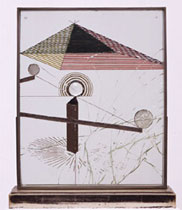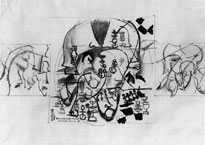Leonardo’s Optics Through the Eyes of Duchamp: A Note on the Small Glass
click to enlarge

Marcel Duchamp,To Be
Looked at (from the Other Side
of the Glass) with One Eye,
Close to, for Almost an Hour, 1918
© 2000 Succession Marcel
Duchamp, ARS, N.Y./ADAGP, Paris
The following example of Marcel Duchamp’s overlooked encounter with the mind of Leonardo da Vinci is excerpted from a longer essay. The edition of Leonardo’s Treatise on Painting referred to is Josephin Peladan’s 1910 French translation Leonard de Vinci, Traite de la Peinture. This publication aroused gr eat interest among the Duchamp brothers and their Cubist friends at Puteaux.
To Be Looked At, With One Eye, Close To, For Almost An Hour (in French: A regarder d’un oeil, de près, pendant presqu’une heure) is a cruel set of commands. Nobody would want to look at anything following this prescription. Duchamp wrote the phrase in small capital letters across the face of a glass painting,
and insisted that his directive, issued in the infinitive, serve as its title. But the owner of this work, Katherine Dreier, hated the title, and referred to it instead as Disturbed Balance.
Duchamp, however, was being uncharacteristically descriptive with To Be Looked At… because the image on glass is based upon optics and experiments with the functioning of the eyes. It follows Leonardo da Vinci’s study of vision.In fact, the idea, the image and the phrase itself all come from this short illustrated passage in the Treatise on Painting (1):
Objects in relief, viewed close up with one eye [vues de près avec un seul oeil], seem like a perfect painting. If the eyes A and B look at Point C, C will appear at
click images to enlarge
Leonardo de Vinci,Treatise on Painting, 1651 © 1910 Joseph Peladan, Leonard de Vinci, Traite de la Peinture, Librairie Delagrave, Paris
D F. But if you look at it with one eye, M, it will seem to be at G.Painting only presents this second form of vision.
click to enlarge

Marcel Duchamp, Note, 1919
© 1993 Pontus Holten, ed.
Marcel Duchamp: Work and Life,
The MIT Press, Cambridge, Mass.
Paintings are flat surfaces.Spacial illusions in paintings are derived from monocular, not binocular,vision. Leonardo was fascinated by the transformation from physiological optics to the artifice of painting, so he studied the behavior of a pair of human eyes. When an object to be looked at is placed close to the face, the paths of vision of the two eyes cross. Duchamp took Leonardo’s X-shaped diagram of cross-eyed vision, along with the wording of his title, directly from this passage in the Treatise. In a posthumously-published sketch for To Be Looked At… he even used Leonardo’s letters “A” and “B” to identify the eyes, or viewing points, represented by circles at the extremities of the cross. But he then placed the configuration on a receding plane, in perspective, and turned it into a pair of giant scissors, a device soon to appear in The Large Glass. Now the cross-eyed observer, it would seem, could cut his way through the visual field by flexing his eyeballs together and apart to make the scissors work. In the small glass To Be Looked At… most of this peculiar tool lies outside the rectangle of the picture, so only its tips can be seen.
The squat, transparent pyramid hovering above the scissors would appear to transport the setting of this one-act farce for eyeballs to ancient Egypt. But it does not.Instead we are right back in the arena of the optics of Leonardo, who wrote frequently and vehemently about the “pyramid of vision.” According to Leonardo:
The body of the atmosphere is full of infinite pyramids composed of radiating straight lines (or rays of light), which are produced from the bodies of light and shade, existing in the air; and the further they are from the object which produces them the more acute they become, and although in their distribution they intersect and cross they never mingle together, but pass through all the surrounding air, independently diverging, spreading, and diffused.(2)
If you look into a mirror and close one eye, you will have formed a visual pyramid pointing at your open eye, whose base is the shape of your face. Leonardo displays remarkable insight into the mechanism of light as it reflects off our surroundings. The receiving human eye always forms the apex of a complex geometric solid, whose base is delineated by the outline of an object in view, and whose sides are formed by the rays of light racing towards the viewpoint from its edges. Leonardo’s use of the word “pyramid,” however, is confusing, because in common usage a pyramid sits on the earth, on a perfectly square base, its axis pointing up to the sky. Duchamp’s Egyptian pyramid in To Be Looked At… is a deliberate and mocking distortion of Leonardo’s idea as it occurs, in the Treatise on Painting, at the center of his theory of optics.
In 1918, from the isolation of Buenos Aires, where he made To Be Looked At…, Duchamp had good reason to poke fun at the visual pyramid. He was probably sick to death of it. His brother, the painter Jacques Villon, was, in contrast, obsessed. Villon believed that Leonardo’s pyramid could provide the unifying theory in his enterprise to make Cubism more than just a passing fad, to transform it into an enduring, classical art form. In 1915, the last time the two were able to meet until after the Great War, Villon would talk of nothing else. All this had started in 1911, when the brothers and their Cubist friends became fascinated by Leonardo’s optical formulations: “Every body in light and shade fills the surrounding air with infinite images of itself; and these, by infinite pyramids diffused in the air, represent the body throughout space and on every side.”(3)
Was Leonardo da Vinci a Cubist himself? He was, it is true, presenting a vision of the space around objects filled with latent images. The eye at any given location could only perceive one image at a time. Visual pyramids “intersect and cross [but] they never mingle together…” But could a painter, a Cubist painter, overcome the laws of light and vision? Could his imagination and intuition capture these half-formed, transparent images, as evoked by Leonardo, before they are condensed into a point, as they overlap, interpenetrate, and jostle for predominance? Jacques Villon struggled to embed this concept of latent visual pyramids into his paintings for the rest of his life.
Marcel Duchamp discussed these ideas with his brother in the early days of Cubism. Then he chose a different path, a directly-perceptual method of creating transparency and overlapping planes in the visual field. He preferred the method that children use. He crossed his eyes.
click to enlarge

Marcel Duchamp,Portrait of
Chess Players, December 1911
© 2000 Succession Marcel
Duchamp, ARS, N.Y./ADAGP, Paris
Only one painting, supported by a group of studies, was produced using the cross-eyed method: the Portrait of Chess Players.
click to enlarge

Marcel Duchamp,Portrait
of Chess Players, December 1911
© 2000 Succession Marcel
Duchamp, ARS, N.Y./ADAGP, Paris

Marcel Duchamp,For a
Game of Chess, October 1911
© 2000 Succession Marcel
Duchamp, ARS, N.Y./ADAGP, Paris
Duchamp asked his two brothers, Jacques and the sculptor Raymond Duchamp-Villon, to sit in front of a chess table, in the midst of a game, and face each other nose-to-nose. Marcel then stationed himself within a foot of his motif, and, in an experiment with scissored configurations of his binocular vision, observed his brothers’
profiles merging and multiplying, engulfing the armies of chessmen behind them. Next, to sort things out, he studied Jacques, on his right, “with one eye, close to, for nearly an hour.” He followed this procedure with Raymond, this time with his left eye, all the while intending the physical proximity of the three artist-brothers (one behind and two in front of the canvas), clustered around their favorite game, to reflect their intellectual and emotional closeness. It is a rare glimpse into a private world.
Duchamp left a clear record of the steps leading up to his finished painting. Five preparatory drawings survive. One is in the format of a triptych, with a central square drawing flanked by two smaller contiguous squares. At first glance it looks as if all three squares are filled with Cubist studies of a man’s head. A closer look reveals Raymond’s, then Jacques’s, physiognomies,delineated separately on either side, on the flanking panels. These two monocular visions are repeated, combined and merged in the central panel, which became the prototype for the final painting, the Portrait of Chess Players. Duchamp had put Leonardo’s visual scissors, as depicted a few years later in the small glass painting of 1918, into practice, in the service of Cubism. He never repeated this experiment.
Notes
 1. Josephin Peladan, translator and editor, Leonard de Vinci, Traite de la Peinture (Paris: Librairie Delagrave, 1910), 113. English translations in A. Phillip McMahon, translator, Treatise on Painting by Leonardo da Vinci (Princeton: Princeton University Press, 1956), 177, and Edward
1. Josephin Peladan, translator and editor, Leonard de Vinci, Traite de la Peinture (Paris: Librairie Delagrave, 1910), 113. English translations in A. Phillip McMahon, translator, Treatise on Painting by Leonardo da Vinci (Princeton: Princeton University Press, 1956), 177, and Edward
MacCurdy, translator and editor, The Notebooks of Leonardo da Vinci (New York: George Braziller, 1954), 241.
 2. Peladan, Leonardo de Vinci, 89. English translation in Jean Paul Richter, The Notebooks of Leonardo da Vinci, Volume I (New York: Dover Publications, 1970), 39.
2. Peladan, Leonardo de Vinci, 89. English translation in Jean Paul Richter, The Notebooks of Leonardo da Vinci, Volume I (New York: Dover Publications, 1970), 39.
 3. Richter, The Notebooks of Leonardo da Vinci, Volume I, 39.
3. Richter, The Notebooks of Leonardo da Vinci, Volume I, 39.

